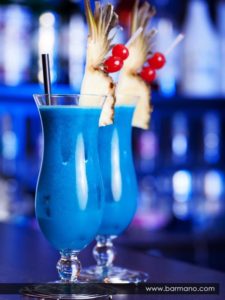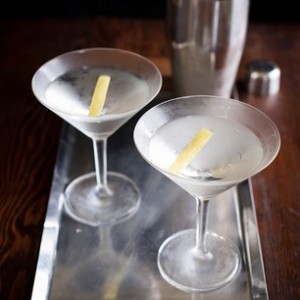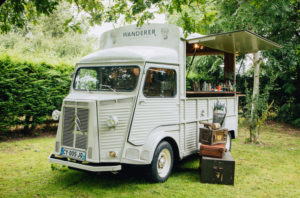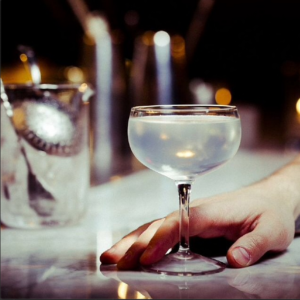Gin Van, Joan Collins and Rare Earth
Reading Time: 4 minutes.
Friday is upon us, so a few notes about cocktails.

The cocktail snob is suffering a (deserved) backlash, as Robert O. Simonson of the New York Times points out in When Bad Drinks Go Good:
Just as the cocktail renaissance has brought renewed fame to classics like the martini, the Manhattan and the Negroni, it has heaped fresh infamy on a rogues’ gallery of less classy concoctions, most of which emerged during the final decades of the last century.
Now a backlash of sorts has begun, as some high-end bartenders apply their skills to a new challenge: doing bad drinks well.
Bars like Holiday Cocktail Lounge in New York; Pépé Le Moko in Portland, Oregon; and the Automatic in Cambridge, Massachusetts, where the martini shares space on the menu with a blue margarita, have risen to this curious challenge.
Whenever I see the Blue Hawaiian cocktail, which is not often, I compusively think of Elvis in Blue Hawaii (1961):
Superb sash.

The martini is not a complex drink.
Mercifully, this article keeps the options simple:
The cocktail world is divided into two camps: those who order martinis and those who don’t. And for those who don’t, it may be because they just haven’t found their best martini yet.
There are many different ways to mix this cocktail, and there’s a recipe out there for everyone ― you just have to know what to ask for when you stroll up to the bar.
Classically, a martini is one part dry vermouth to four parts gin. But that recipe is not set in stone ― here are eight different ways you can order the cocktail. Figure out what’s right for you and have a better happy hour.
Read the entire article: How To Order A Martini Like A Total Pro.

A great concept from the United Kingdom: a mobile gin van:
Forget hosting a BYOB gathering, you can now pay for a mobile gin van to deliver delicious drinks straight to your party. The catch is that you can’t have the van, called The Wanderer, on speed dial for a quick drink or two.
Instead, the van, created by New World Trading Company (NWTC), has to be hired as a fully-kitted mobile bar, so it’s more suitable for weddings and big celebrations than your average house party.
Still, dedicated gin fans may be tempted to club together for an extravagant Saturday night after hearing what the van offers.
Read the article by Rachel Moss: This Mobile Gin Van Will Deliver Cocktails Straight To Your Party (But There’s A Catch).
From the UK’s Daily Mail, an article on retro drinks and the current popularity of bitter drinks (the Negroni) and ingredients (such as Campari, Cinzano and Aperol):
Speaking about the new trend, John Vine, drinks buyer at Waitrose, said: ‘Bitter notes can be refreshing and act as a foil to sweetness , the right balance makes for the perfect cocktail.’
His comments correspond with data from the store, which shows a thirty five per cent sales increase in sales of Cinzano, which is perhaps best known for its placement in the iconic TV advert featuring Leonard Rossiter and Joan Collins.
I am a fan of bitter cocktails and have written previously about the Negroni. Such drinks reflect, in some ways, this vale of tears through which we pass.
Failing to recall the “iconic TV ad,” I looked it up:
Outstanding. According to the Campari corporate website:
Rated 11th best TV commercial of all time, the most famous Cinzano TV ads were those of Leonard Rossiter and Joan Collins during the 1970s. The infamous couple engaged in 10 unforgettable slapstick sketches that always ended in Rossiter pouring a glass of Cinzano on a progressively more resigned Joan Collins.
Here is another one, this time about rose.
The Gin Corner
Rose be damned. I am partial to gin. Spaniards apparently take their gin and tonic seriously:
“In Spain, gin-tonic is not just a cocktail, it is an obsession,” says José Andrés. Here’s everything you need to know to nail this iconic drink at home—and six places in the States with excellent G&T options.
- In Spain, fresh herbs (lemon verbena, rosemary or lavender), lemon peel, juniper berries, edible flowers and even whole spices are used to enhance the gin’s botanicals.
- Spanish bars stock as many as 50 different gins. Our choice: a London dry style. José’s two favorites: Rives Special Premium Tridestilada from Andalusia and Xoriguer Gin de Mahón from Menorca.
- Amplify the aroma of the gin and the garnishes with a large wine glass or goblet.
- Big ice cubes keep your gin-tonic chilled without watering it down.
- Look for tonic made with cane sugar or agave (not high-fructose syrup), such as Q, Fever-Tree or Fentimans, for a balanced mix of sweetness cut with quinine bitterness.
In particular, I endorse lemon (rather than lime); lots of ice (most G&Ts are insufficiently cold); and high-quality, non-syrupy tonic.
Read the full article here: How to Make the Perfect Gin and Tonic, According to José Andrés.
Also, from the Boston Globe, a recipe-filled article for new gin cocktails from New England distillers.

Finally, here is a recipe for the Joy Division cocktail. This may be worthy of a try: at times, I will rinse the inside of a martini glass with absinthe, which manages to simultaneously slow down and speed up the gin.
I know little of the post-punk English band from which the cocktail takes its name, although one of my favorite crime writers, Ian Rankin, used the title of one of their songs for a book title.
More to my taste, and to start you into your weekend, is Rare Earth’s 1970 version of “Get Ready”: